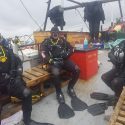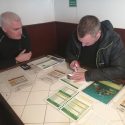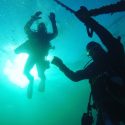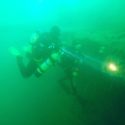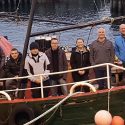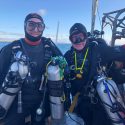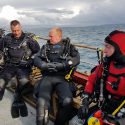2019 was a significant year for several reasons. One of the biggest in the SCUBA Diving Calendar was the Centenary of the scuttling of the German High Seas Fleet in Scapa Flow after the end of the First World War. This was marked with events throughout the year including the BSAC SCAPA 100 project that encouraged divers to visit and dive the multitude of wrecks and salvage sites to commemorate the centenary.
5 members of 7 SCOTS, supported by 2 from the RAF and 1 Royal Marines conducted an expedition to Scapa Flow in October, staying aboard the MV Jean Elaine we spent a week in thankfully un-October like weather diving a number of wreck sites over the week. The opportunity was also taken to develop the skill set of the less experienced divers increasing their depth qualifications, improving their buoyancy and trim and introducing them to some of the more technical aspects of deeper and longer diving such as Decompression procedures.
I include myself in this cohort. Despite having around 60 dives in my log and having been qualified as a Sports Diver for a couple of years I have not done a huge amount of diving in the UK. Diving in a Dry Suit in the colder UK waters is a skill in itself. To then push ourselves to dive deeper (within our qualifications) into the often quite poor visibility of the dark waters in Scapa Flow around the Wreck Sites certainly pushed me towards the edge of my comfort zone.
The Expedition gathered in Elgin early on Sat 12 for the long (but stunning) drive up the A9 to Scrabster to catch the ferry to Stromness on Orkney. Our Dive Boat for the week, MV Jean Elaine is moored in Stromness harbour as well so in short order we had our kit on board and made our way to the local supermarket to purchase our provisions for the week before settling in for an early night in the “compact and bijou” accommodation the MV Jean Elaine offers.
After an early rise on Sunday morning and a quick bite of breakfast and we were on our way to the first couple of dives, the transit offering us the chance for last minute kit checks and preparation. We were to dive the wreck of the SMS Karlsruhe, the shallowest of the Light Cruiser wrecks lying in 25m as our “shake out” dive to get back into the swing as a few divers had not managed to dive for a couple of months before the Expedition. This was followed by a shallow dive on the V83 Torpedo boat and was our first introduction to the “Buoyancy and Trim workshop. Suffice to say some found this easier than others!
Day 2 saw us heading to the wrecks of the SMS Cöln and the SMS Dresden and for many of us our first experience of diving with a “stage” a second cylinder completely separate from your primary cylinder on your back, this is a pre requisite for diving to deeper depths under Military rules. Despite the encumbrance on the boat these actually proved to be much easier to manage in the water than I was expecting. One of the best features of the boat we were diving from was the Diver Lift that you swam onto at the end of your dive which then lifted you from the water onto the deck! A luxury I will miss next time I am diving from a RHIB.
The Accelerated Decompression Procedures course we were taking requires a number of theory lessons as well as practical dives using the Stages etc and these lessons were delivered in a makeshift lecture room in the main galley on the MV Jean Elaine. This meant the next couple of days were a mix of: get up and travel to the days Dive site, do the first dive followed by a theory lesson over lunch while moving to the second site for the second dive and then a return to the harbour and some more theory.
During these dives we visited SMS Kronprinz Wilhelm, the SMS Brummer, the debris site where the SMS Seydlitz was salvaged and the F2 Escort boat (which actually sunk in 1946 after coming into British hands at the end of the Second World War).
Now that we were getting more experience with the Stages and the Decompression Procedures it was time for us to head to the SMS König, one of the 3 Battleships in the Scapa Flow Waters. lying in 38m so only the very bottom now out of reach to us qualified to 35m. The scale of this wreck is something to behold. Descending down the shot line the shape wells up out of the gloom and it is difficult to get a sense of what you are actually looking at. Eventually details come into focus and you realise how big the wreck is (nearly 27000 tons and 146m long!) and you start to explore. All too soon you need to return to the surface leaving the wreck behind knowing there is a huge amount more to see. Definitely one on the list for a re-visit.
The last few dives saw us revisiting some of our favourite wrecks of the week, the SMS Cöln, the SMS Kronprinz Wilhelm and the SMS Dresden. The atmosphere on all 3 of these dives being completely different to our first dives into the unknown. Changes in visibility, confidence and experience meaning we noticed many things we hadn’t seen on our first dives, even training into account the fact we were still practising our newly mastered skills.
So was the expedition what I expected? Absolutely. All that and more. Scapa Flow rightly deserves its reputation as a world class wreck diving site and we only touched a small portion of the diving available in the week we were there. This doesn’t take into account all of the other diving available in other parts of the waters around Orkney. A fantastic experience and one I am extremely grateful to have been a part of.
In summary, as the 2019 dive expedition draws to a close, it’s time to reflect on what has been an excellent year of diving for members of 7SCOTS culminating in this excellent diving expedition. A huge thanks to our Sub Aqua Diving Supervisor (SADS), Capt Ken Scott and our Advance diver, Capt Steve Dawson who willingly have passed on their experience and knowledge to us all. Thanks, must also go to those outside organisations that supported us financially with a special mention to The Ulysses Trust, without this support these expeditions could not happen.
Capt Mike Dunnigan

